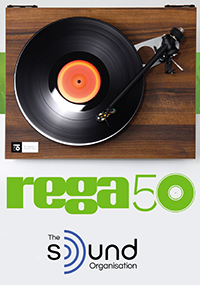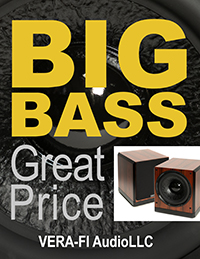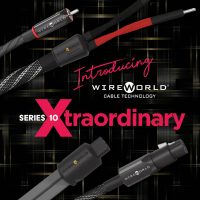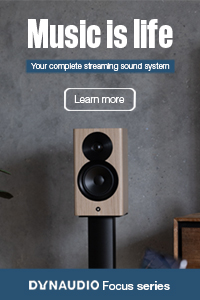 “Open the pod bay door, Hal.” As I unbox the Chord Chordette QuteHD DAC, I cannot help but recall that famous quote from Stanley Kubrick’s 2001: A Space Odyssey. The Cordette is indeed reminiscent of the HAL 9000 computer from the movie, complete with a large, round eye, which offers a view into the internal circuitry. This window emits a variety of colors from the device’s internal LEDs, and the red glow, which appears when the DAC is converting a 44.1-kHz signal, is eerily HAL-like. Other colors appear at higher bitrate conversions, and the Chordette is capable of handling a whopping 32-bit/384-kHz signal.
“Open the pod bay door, Hal.” As I unbox the Chord Chordette QuteHD DAC, I cannot help but recall that famous quote from Stanley Kubrick’s 2001: A Space Odyssey. The Cordette is indeed reminiscent of the HAL 9000 computer from the movie, complete with a large, round eye, which offers a view into the internal circuitry. This window emits a variety of colors from the device’s internal LEDs, and the red glow, which appears when the DAC is converting a 44.1-kHz signal, is eerily HAL-like. Other colors appear at higher bitrate conversions, and the Chordette is capable of handling a whopping 32-bit/384-kHz signal.
The Chordette measures only 6 inches wide, 3 inches deep and 1.75 inches tall, which allows placement on a shelf or next to an existing piece of equipment on your audio rack. The anodized aluminum exterior has nicely rounded edges and is available in a variety of colors, including blue, black, and silver. The DAC’s power arrives from a thin-wired wall wart. For those seeking a minimalist audio solution, the Chordette provides a welcome form factor.
“It can only be attributable to human error.”
Setup proves very straightforward, with the Chordette offering one option for the analog output: a stereo pair of single-ended RCAs. Users do have the option to connect it to digital sources via USB, optical or coaxial inputs. It’s important to note that the coax input is in the form of a BNC connector, not the more common RCA variety, so those wishing to connect a source using this input will need the appropriate cable. BNC connectors are great for their ability to transfer a signal and physically lock onto their receptacles, but I’d like the option to connect both types of coax inputs. Luckily, I have a Stereovox XV2 digital cable on hand that offers BNC on one end and RCA coax on the other.
Installing the Chordette is simple and seamless, with the packaged CD containing drivers for the USB setup. Once I place the disc in my PC, connect the USB cable and power up the Chordette, Windows 7 has no problems recognizing the DAC and activating the needed drivers. Mac users need only go to their control panel and select the Chordette as their digital output device.
The Chordette is a black-box solution, meaning there are no buttons, switches or knobs to control it. Simply connect your digital sources and the DAC takes care of everything else. Without an input selector, the Chordette prioritizes incoming signals when multiple inputs are connected simultaneously. For instance, if coaxial and USB cables are both connected to the unit the default priority is the USB input; optical is the lowest priority. When I pause the USB source material from the computer, the Chordette begins its search for the next-ranked input source, which in my case is the coax connected to a CD player. After about 20 seconds, it resumes playing the second source automatically. For those with a single digital source this could not be simpler. For those with multiple sources, it’s mostly a matter of stopping any source you don’t want to hear. Even when unplugging the USB cable in the middle of a song, the DAC makes a quick search and, after a pause, it moves on to the next available connected source.
 “I’d like to hear it, HAL. Sing it for me.”
“I’d like to hear it, HAL. Sing it for me.”
With the Chordette, joys are many and quibbles are very few. It creates a supplemental “drive” to the music. It doesn’t actually speed up a song, but it creates a subtle sense of urgency that pulls in (and holds) the listener. Attack on guitar plucks and drum beats in Gipsy Kings’ Ritmo de la Noche commands attention, but it never overpowers the big-picture musical experience. Yet, on smaller-scale solo performances, the Chordette still accentuates delicacy and nuance, making this DAC a great option for all types of music.
The Chordette provides a nicely balanced presentation across all frequencies. Highs are realistically and enjoyably rendered; mids are smooth and lifelike; and bass presentation is punchy, full and deep. One small experiential variance from my usual reference, in the form of “Otherwise” by Morcheeba, reveals low bass notes pushing upfront in the virtual stage and competing a bit with the vocals. Admittedly, I enjoy a little extra heft in some recordings so this aspect will prove a non-issue for many listeners, especially those with smaller speakers.
This DAC also provides a stellar level of detail across all sample rates. Even a 48-kHz translation demonstrates audible improvement over a standard 44.1-kHz CD. A CD of the Connecticut Early Music Ensemble performing Vivaldi’s Four Seasons puts a shiver down my spine during a few passages—an experience I don’t have too often. With ribbon tweeters, a small amount of perceivable sharpness emerges at times in lower-resolution digital recordings, which can detract from the musical experience. But this DAC really draws me into the musicality of a song rather than simply evaluating the equipment producing it.
When I use the Chordette’s coax connection to a CD-quality source, the sound is marvelous. However, the perceived width of the performance has some limits. Air’s “Venus” provides a good test for this. With some other DACs, the musical experience extends well beyond the speakers’ limits and remains there. The Chordette is reined in a bit and does not exceed the physical speaker boundaries to the same degree. I do find some improvement in this regard when using the USB connection, or when using a dCS Purcell to upsample to 96 kHz.
What the Chordette creates between the speakers is both dramatic and convincing. Johnny Cash’s cover of “Danny Boy,” recorded late in career, reveals the age in Cash’s voice. There’s an emotional undertone in it that transcends the song itself, especially when accompanied by the distant-sounding pipe organ. For those wanting to experience every nuance up close, in a front-row seat, this DAC enables that experience. Those who prefer to sit further back at a performance may find the detail a bit much. But even for those listeners, I expect many will enjoy the change of seat location as the Chordette ushers them toward it.
“Road to Hell: Part I” by Chris Rea sonically simulates a person driving a car down the highway in the rain. On this track, the Chordette does an incredible job recreating front-to-back depth and layering. Windshield wipers scrape from side to side, the radio switches between various news stations and many cars drive by in the distance with a whoosh. The portrayal of these elements though the Chordette is exciting: The passing cars sound well behind the speakers, with their tires rolling over a wet road; the wiper blades appear ahead of the listener, as though clearing rain from a pane of glass between the speakers (you can hear that the driver needs to buy some new blades); and the simulated radio stations, with news updates panned left and right, have a sound one would expect from old car speakers.
 “You guys have really come up with somethin’.”
“You guys have really come up with somethin’.”
When asked about its status, the HAL 9000 replied, “I am putting myself to the fullest possible use, which is all I think any conscious entity can ever hope to do.” While obviously not conscious, the Chordette QuteHD certainly puts its skills to the fullest possible use in a home audio system. The team at Chord Electronics has done an outstanding job designing and voicing this amazing little DAC. It offers flexible input options, a very small footprint and extreme ease of use, as well as adaptability for both low- and high-resolution digital sources. Combining these attributes with wonderful sound, this DAC proves a marvelous addition to a stereo setup. For those evaluating DAC options around the Chordette’s $1,700 price range and who enjoy feeling like they are in the front row at a musical performance, the Chordette is a fantastic option.
Chordette QuteHD DAC
MSRP: $1,700
Chord Electronics
Peripherals
| Speakers | Piega P10 |
| Amplifier | Mark Levinson 335 |
| Preamplifier | Coffman Labs G1-A |
| Digital Sources | Audio Research CD3 MKII dCS Purcell processor EAD 9000 MKIII DAC Genesis Technologies Digital Lens |
| Cables | Jena Labs Valkyrie and Symphony interconnects Jena Labs Twin 15 speaker cables |
| Power Conditioner | Running Springs Audio Haley |
| Power Cords | Cardas Golden and RSA Mongoose |
| Accessories | Mapleshade SAMSON racks and shelves ASC TubeTraps Cathedral Sound room-dampening panels |















